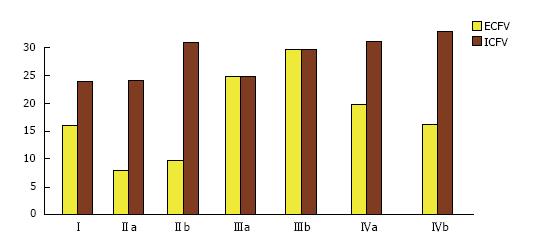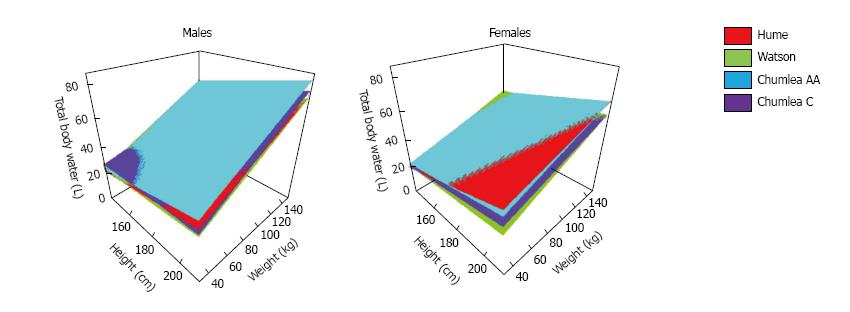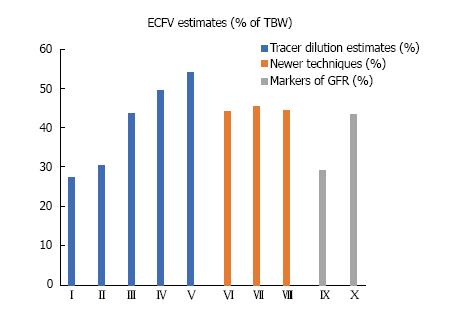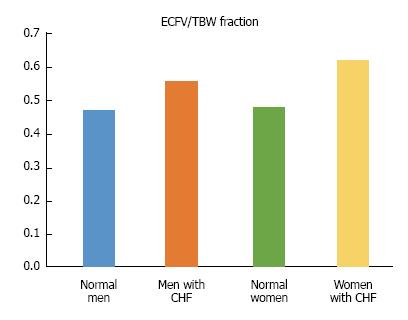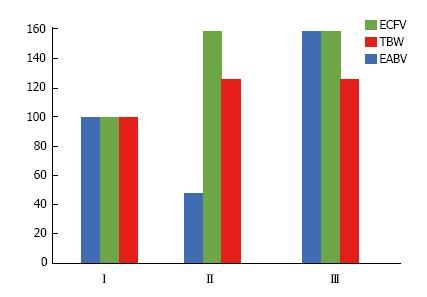Copyright
©The Author(s) 2018.
Figure 1 Body compartment volume (L) in the three categories of hyponatremia.
I: Normal state: ECFV = 16 L, ICFV = 24 L, serum sodium concentration ([Na]S) = 140 mmol/L. II: Hypovolemic hyponatremia; IIa: Loss of 8 L of isotonic sodium solution: ECFV = 8 L, ICFV = 24 L, [Na]S = 140 mmol/L; IIb: Gain of 8 L of water; ECFV = 10 L, ICFV = 30 L, [Na]S = 112 mmol/L. III: Hypervolemic hyponatremia; IIIa: Gain of 8 L of isotonic sodium solution; ECFV = 24 L, ICFV = 24 L, [Na]S = 140 mmol/L; IIIb: Gain of 8 L of water; ECFV = 28 L, ICFV = 28 L, [Na]S = 120 mmol/L. IV: Euvolemic hyponatremia manifested in the syndrome of Inappropriate ADH secretion, which combines water gain and sodium loss[38,39]; IVa: Gain of 8 L of water; ECFV = 19.2 L, ICFV = 28.8 L, [Na]S = 116.7 mmol/L; IVb: Loss of 560 mmol of monovalent sodium salt (e.g., NaCl); ECFV = 16 L, ICFV = 32 L, [Na]S = 105 mmol/L. ECFV: Extracellular fluid volume; ICFV: Intracellular fluid volume.
Figure 2 Total body water estimates from anthropometric formulas.
Estimates of total body water computed by the Hume et al[63], Watson et al[64] and Chumlea et al[65] anthropometric formulas for men and women with the same age (40 years) and varying height and weight. AA: African American; C: Caucasians.
Figure 3 Average extracellular fluid volume estimates expressed as percentages of total body water.
I-V: Tracer dilution estimates[46]; I: Sucrose, thiosulfate; II: Mannitol, sulfate; III: Bromide, chloride; IV: Sodium; V: Thiocyanate; VI-VII: Newer techniques; VI: Dual-energy X-ray absorptiometry[130]; VII: Bioelectrical impedance[115]; VIII: Simultaneous determination of total body potassium and total body water[195]; IX, X: Glomerular filtration rate markers; IX: Inulin[139]; X: Iothalamate[147]. ECFV: Extracellular fluid volume; TBW: Total body water.
Figure 4 The fraction extracellular volume over total body water in elderly subjects with relatively compensated congestive heart failure and healthy controls.
Mean values ECFV/TBW in the study of Sergi et al[228]. The mean ejection fraction of elderly patients with relatively compensate congestive heart failure (CHF) and absence of pleural effusion was 40%. Total body water (TBW) was measured by 2H2O dilution and extracellular volume (ECFV) by bromide dilution. The fraction ECFV/TBW was significantly higher in subjects with CHF.
Figure 5 Percent changes from normal of body fluid compartments in hypervolemic states.
I: Normal body fluid state; II: Congestive heart failure, hepatic cirrhosis, nephrotic syndrome with underfill mechanism of fluid retention; III: Nephrotic syndrome with overfill mechanism of fluid retention. EABV: Effective arterial blood volume; ECFV: Extracellular fluid volume; TBW: Total body water.
- Citation: Roumelioti ME, Glew RH, Khitan ZJ, Rondon-Berrios H, Argyropoulos CP, Malhotra D, Raj DS, Agaba EI, Rohrscheib M, Murata GH, Shapiro JI, Tzamaloukas AH. Fluid balance concepts in medicine: Principles and practice. World J Nephrol 2018; 7(1): 1-28
- URL: https://www.wjgnet.com/2220-6124/full/v7/i1/1.htm
- DOI: https://dx.doi.org/10.5527/wjn.v7.i1.1













